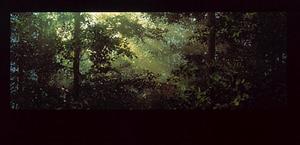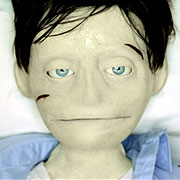“{Dimension Films exec Andrew] Rona is only too delighted to play the heavy and play it to the Mephistophelean hilt. In fact, when the studio doesn’t get its way in the selection of a director, he signals that he will make that director’s life a living hell.”
Sounds like a nice plot for a reality series.
Since Project Greenlight started burning $1 million/film on the corner-cutting ghetto end of the Hollywood production system, fifty, a hundred, actually good films were made for even less money. One of these days, Greenlight should show someone spending the money smartly. Even though it’d mean less air time for Chris Moore.
Making It, and Taking It on the Chin from a Studio Bigwig [nyt]
Project Greelight site [liveplanet.com]
[update: the timing and content of this post and the appearance of an ad for Reality Green Light’s contest to find a winning reality series idea is pure coincidence. Obviously, if I’d known about the contest this morning, I wouldn’ta gone and blabbed my kick-ass idea, yo. Damn.]
Damien Who?
From the Times:
But, at first, the thought of painting in this Photo Realist manner intimidated him. When he began in earnest about three and a half years ago, he realized why.
“I started out airbrushing,” he said. “But the images looked flat, dead. For two years I didn’t think it was going to work.” Finally, he said, he disciplined himself to represent each image faithfully by hand.
Still, he doesn’t consider himself a serious painter. “I would feel uncomfortable putting myself in a category with other painters like Goya or Bacon,” he said. “I’m more interested in the images than the painting.”
From Linda Yablonsky on Artforum.com:
Though many guests made the connection, Hirst may have thought he was avoiding comparisons to Jeff Koons by ordering hired hands to paint each piece in this chilling body of work rather badly. (One assistant was reportedly fired for painting too well.)
But I hope he didn’t think he was avoiding comparisons to another Damien who makes paintings “in photo-realist style from pictures in magazines and print ads”: Damien Loeb.
But my favorite quote from Yablonsky captures a whole swath of the art world’s, “I’m here, so it must be important” sense of audacious self-consciousness, without a hint of self-awareness:
At these prices [up to $2mm] it’s difficult to understand how paintings that are not going to get any better with time can continue to acquire value. Though truth be elusive, let’s just say that that is exactly Hirst’s point: to empty art of meaning. In a market where money is so disposable, how can art transcend mere currency to become more than just a brand? If this is indeed Hirst’s message, then he has issued a galling challenge to every other living artist. It will be interesting to see who takes it up.
Or not. Because it’s not like anyone’s ever paid more than $2 million for a painting before, or even for a Hirst.
As some smart aleck said in the NY Times, “Just because you’ve spent a lot of time and money on something doesn’t mean it’s very good.”
Taste for the Macabre but No Pickled Sharks [nyt]
High and Dry, Linda Yablonsky [artforum.com]
Let The Name…’Moses’…Be Stricken From Every Public Obelisk…
So let it be written, so let it be done.
Many of the thousands of Ten Commandments statues gracing public parks, courthouses and city halls around the country–including the one whose constitutionality is being considered by the Supreme Court–were placed by Cecil B. DeMille and the Fraternal Order of Eagles as a promotion for the film. Charlton Heston, Yul Brynner, and Martha Scott attended many of the monument unveilings.
Many Commandments monuments started out as movie promotion [dallas morning news, via mefi]
“shaped by their directors’ experiences with grief”
The lingering after-effects of tragic loss are figuring into American feature films now. Some films are specifically–if obliquely–related to the September 11th attacks, but others can be attributed to a post-9/11 heightened sensitivity to the nuances of experiencing a loved one’s death.
Makes sense to me; I set my first short, Souvenir November 2001 in this aftermath, after the active, self-conscious mourning is past. People say that the hardest time is actually several months after the funeral of someone close, because people have usually stopped actively checking on you, and the reality of that person’s absence really starts to sink in.
9/11 Is Sneaking Onto a Screen Near You [nyt]
Movie Theatre Rwanda
The awesome Haitian director Raoul Peck’s new HBO film about the Rwandan genocide, Sometimes in April, was the first film shot in Rwanda, and so he promised to debut it there as well.
Writer Melanie Thernstrom writes about attending the packed, tense screening, which was held in a giant stadium in Kigali.
A View To A Killing Field [nytimes.com]
Sometime in April premiers on HBO Mar. 19 [hbo.com]
Related: Thernstrom’s book, Halfway Heaven, about the violent deaths of two immigrant students at Harvard, and an article about Adrian Nicole LeBlanc’s 2003 epic novel-like reporting in Random Family: Love, Drugs, Trouble, and Coming of Age in the Bronx [nymag]
10 lbs of HBS in a 5 lb bag
So you mean this whole “HBS rejects applicants who ‘hacked’ into admissions site” hubbub is about people seeing what happens if they truncate the URL for their account?
I guess they’ve got a brand image to protect as the home of the utterly and irrationally technology-ignorant executive of tomorrow. IT people–hell, people who know how to change their default browser settings–everywhere are shaking their heads.
Business schools redefine hacking to “stuff that a 7-year-old could do” [phil greenspun]
Nice, Minnesota
Several years ago, at the opening dinner of a sculptor friend’s debut 2-person show, I found myself playing the oh-so-sophisticated New York collector at a giant round table in a Chinese restaurant for a mix of folks, including the other artist’s parents.
I offhandedly pronounced Minneapolis to be the most Canadian of American cities: not just because of the freakin’ weather, but because of public radio. First, there’s Garrison Keillor, and besides, everyone–including every immigrant taxi driver I met–listened to public radio.
Well, the other artist’s mother said, we’re from Minneapolis. Apparently, calling a Minnesotan Canadian is almost as bad as calling a Quebecker Canadian, except the Minnesotans are too nice to say anything; they just keep it all inside. And of course, they’re so hardy, they didn’t need a jacket for the chill that blew over the table. My recovery attempt–“I meant Canadian in a good way. As It Happens is one of my favorite CBC shows!”–was unwelcome, and the table split into two conversational crescents for the rest of the night.
Anyway, I was reminded of this this morning when Rex pointed out that “Live in Canada” is one of Minneapolissers Minneapolitans’ most popular goals. [of course, since in the two days since he posted it, it’s dropped from #11 to #18, so they must still be very self-conscious about it.]
[update: and they’re quick to correct. I didn’t really think it was Minneapolisser, but I figured–rightly–that someone’d clue me in real fast. Thanks, Jason.]
This Explains A Lot
The cannabis connections of the Ocean’s 12 cast and crew [via kottke, party on, dude!]
Has Anyone Seen The Flavin Show in Fort Worth?
AND at The National Gallery? I’d love to hear how it’s installed in Ando’s (probably) more sympathetic building.
Huh. They call The Modern Art Museum of Fort Worth “The Modern”.
Clear Your Calendars [Except For Your Therapist]
The BFI’s National Film Theatre is running a complete Tarkovsky retrospective through March 30. It includes new prints of both Solaris and Stalker. And who can pass up seeing Andrei Rublev on the big screen? [I know everyone in NYC passed up seeing it on video; I bought an utterly unused copy, fresh from the newly dead Kozmo.com, on ebay a few years back.]
NFT: Andrei Tarkovsky [bfi.org.uk, via kultureflash]
Read What I Read, Not What I Write
Poss. alt. title: greg.org reads the NYT to you.
If you have to tell someone to be cool…
it’s already too late, they’re not. If only the movie were as well done as Mahnola Dargis’s review.
added bonus: NYTimes.com, HTML hand-coded, just for you: “,em>This film is rated PG-13”
Manohla Dargis’s review of Be Cool [nyt]
On Demand
 The other night Thomas Demand offhandedly described some of the insane details of the production of Clearing, the massive photograph of a forest which is now built into The Modern at MoMA. The photograph was laminated onto two sheets of architectural safety glass that were so large, they had to use satellite-curing ovens at ESA, the European Space Agency–at night–to fabricate it. When the request for the work, Thomas said, “no one quite knew what they were getting.”
The other night Thomas Demand offhandedly described some of the insane details of the production of Clearing, the massive photograph of a forest which is now built into The Modern at MoMA. The photograph was laminated onto two sheets of architectural safety glass that were so large, they had to use satellite-curing ovens at ESA, the European Space Agency–at night–to fabricate it. When the request for the work, Thomas said, “no one quite knew what they were getting.”
[On an irrelevant note, the lifesize set for Clearing happened to be in Demand’s studio during a MoMA Jr Associates visit I set up. It was so stunning, the trustees quickly added the studio to their Berlin itinerary, and curator Kynaston McShine suggested the Modern acquire the work. And I still can’t get a reservation.]
I mention this–obviously I mention the studio story for self-aggrandizement, but remember the tagline of this site, yo–because not quite knowing what you’re getting seems like one of the underlying currents of Demand’s work.
Walking through the show, I tried to recall the portentous actual setting that was obscured behind each photograph’s generic title: Kitchen was Saddam’s, Archive was Riefenstahl’s, etc., but I kept remembering them wrong, which made me load all kinds of historical baggage onto each image; turns out only some of the bags actually matched. Barn was Pollock’s, not Kaczynski’s; the cluttered desk was L. Ron Hubbard’s, not Bill Gates’. The Bauhaus-style stairway was from Demand’s middle school, but it turns out even he remembered it wrong.
Thomas Demand opens today at MoMA [moma.org]
Michael Kimmelman calls it “hypnotic” [nyt]
No one goes to The Modern; it’s too crowded
I’m Your Puppet
 Interpol’s video for “Evil” from their recent album “Antic” was directed by the artist/CG animator Charlie White. It features an Interpol-ish puppet–“pale, thin, with dark hair and a boyish-man quality”–that looks like White’s trademark alien/troll figures in human drag.
Interpol’s video for “Evil” from their recent album “Antic” was directed by the artist/CG animator Charlie White. It features an Interpol-ish puppet–“pale, thin, with dark hair and a boyish-man quality”–that looks like White’s trademark alien/troll figures in human drag.
MTV.com has some press junket-level technical details of the making of.
Interpol’s ‘Evil’ Is More Like ‘Creepy’ [mtv.com, via fimoculous]
Previously: greg.org on Interpol
This is your brain on Gehry. Any Questions?
Since it was opened, the polished stainless steel roof on Frank Gehry’s Disney Concert Hall in LA has been throwing off so much glare, people are getting baked alive in the neighboring condominiums. And on the street, fuggedaboutit. They’re frying eggs and dog’s brains on the sidewalk.
The result: the County Board of Supervisors has ordered a bunch of workers with hand sanders to climb up there and dull the thing down a bit. Meanwhile, some tourist from New Jersey, 3,000 miles away, thinks they should leave it alone.
Disney Concert Hall to lose some luster [LAT, via BoingBoing]
Related: Frank Lloyd Wright’s Ennis-Brown house was “red-tagged,” meaning no one can enter it, after a inspectors noticed a rainsoaking-related shift in a retaining wall. [LAT, via archinect]
